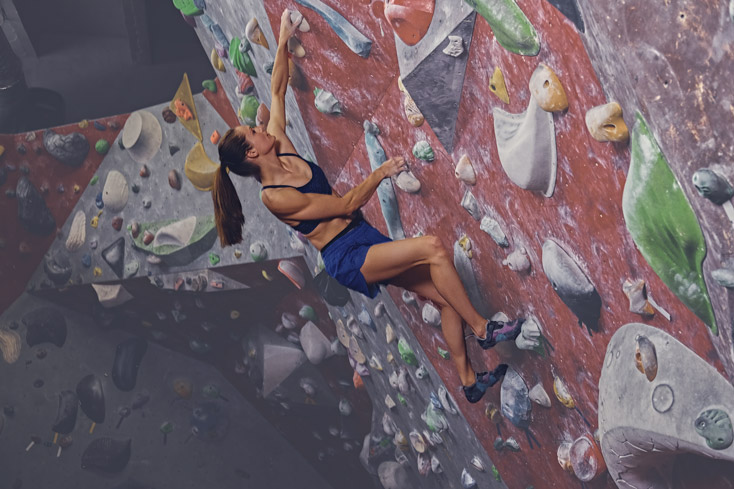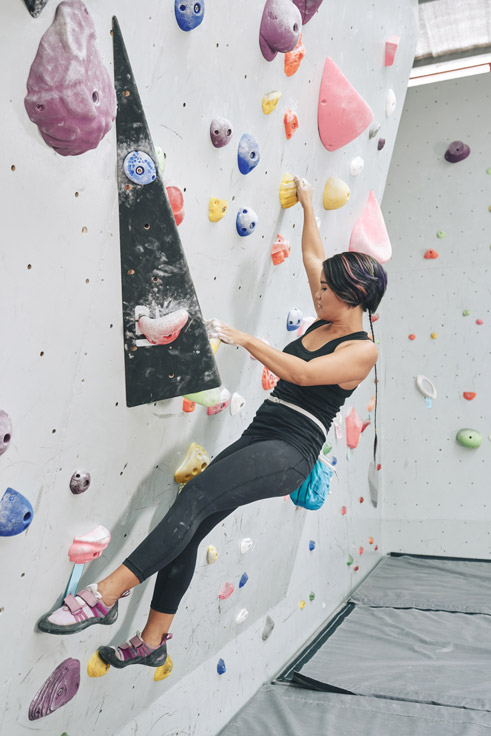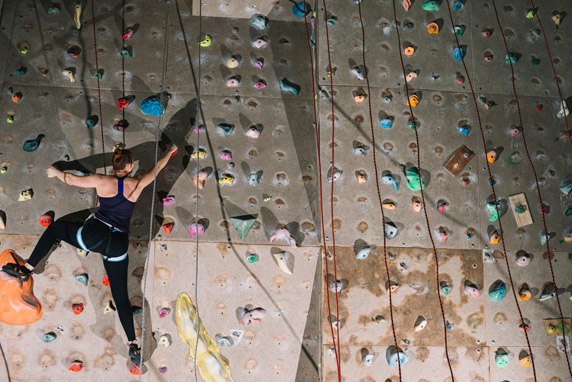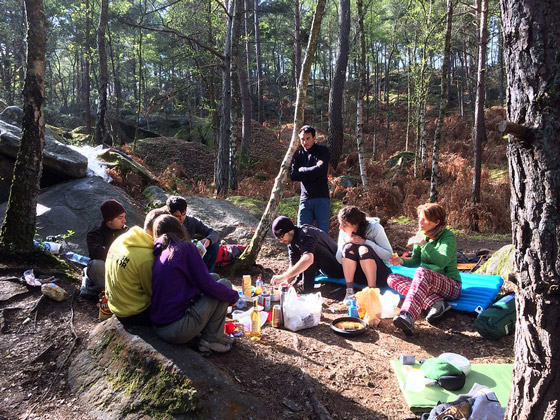Bouldering can be argued as the hardest form of rock climbing because it requires a specific solution (beta) to successfully ascend a problem. Aside from intuition, bouldering also requires a combination of skill and strength.
It’s by no means an easy sport to get into, but it’s a darn fun one. In this article, we’ll look at what makes bouldering difficult, compare it to roped forms of climbing and I might try to convince you to try it out if you haven’t already.
📚 Learn more about bouldering in our Bouldering Beginners Guide
Reasons why bouldering is hard
Here are the three main reasons why bouldering is difficult.
👉 Bouldering requires problem-solving
Most people, when they think off rock climbing, imagine the act of physically climbing up a vertical route. The route has hand and footholds going all the way to the top. Other than requiring the skill and technique to climb the route, the climb itself is pretty straightforward.
When your average person hits a climbing gym, they expect exactly that. Easy, straightforward routes going all the way to the top. And if they hit a top-rope gym, their expectations will be met. However, if they visit a bouldering gym, they might be confused about how ‘hard’ the problems are.

A lot of the difficulty lies in the problem-solving part of bouldering. Unlike many a roped climb, you can’t hop on and expect to make it to the top on strength and skill alone. Oftentimes you will hit a roadblock along the way. You might be strong enough, but if you don’t use the correct ‘solution’ or ‘beta‘ you won’t make it to the top.
The problem-solving nature of bouldering makes it harder for beginners to get into the sport. Additionally, it tends to humble roped climbers making their first visit to a bouldering gym.
One of the best parts of bouldering for me is when everyone in the bouldering gym collects at the newly set wall and tries to solve the problems together. Even though bouldering is a solo activity, it never feels like you are climbing alone.
👉 Bouldering requires strength
Bouldering is a full-body workout. Muscle groups such as core, back, shoulders, forearms, glutes and legs are vital to getting you to the top. Much of your rate of progression in bouldering will depend on how strong you are. Someone who regularly trains their body is going to progress at a much faster rate than someone who doesn’t.

The prerequisite of strength is especially noticeable in beginner climbers. It’s not uncommon for strong people to skip the beginner grades. Even without climbing technique, or beta, strong people can force themselves through these initial grades.
Those who don’t posses the necessary strength will have to develop their climbing technique to progress through the beginner grade range. Relying on technique, as opposed to strength, offers a much better base for climbing but strength becomes inescapable later on.
📚 Related : Complete Guide to Climbing Technique
Rarely will you see an unfit person climb anything over V5 (just like you won’t see anyone climb above this grade without technique). Beyond this point, climbers are required to carry their entire bodyweight at their fingertips.
👉 Bouldering requires technique
While it’s true that strong climbers can force themselves through the beginner grade range without applying an ounce of technique, that doesn’t mean technique isn’t a huge part of bouldering.

Technique is just as important, if not more important than strength in bouldering. By applying technique, a climber can ensure they expend as little energy as possible. But technique has more application than making climbing energy-sufficient. Proper technique is often a necessary part of the solution to a boulder problem.
Without correct body tension, overhung problems are near impossible. Without a smear, a short climber might not be able to reach the next hold. Sometimes a simple flag will decide whether you stay on the wall, or fall off.
I could go on and on about climbing technique and how it is essential to bouldering, but if you’re interested in that you should just read our corresponding article.
Is bouldering harder than roped climbing?
👉 Bouldering is much harder than top roping
A casual climber, who has gone top-roping a couple of times, is going to get humbled hard if they visit a bouldering gym. Most top ropers will climb a route and if they fall off, hop right back on (without being lowered to the floor) and continue their ascend as if nothing happened.

I’ve always found this type of climbing to give a false sense of achievement. Did you really top a climb if you fell 10 times and the rope was keeping you up?
This is where bouldering differs from top-roping. If you fall, you have to start over from scratch. Sure, you’ll often see climbers working on their crux by skipping the first steps but they will never consider it an ascend if they didn’t start from the bottom.
👉 Bouldering is harder for beginners
Aside from the initial difficulty raised by its problem-solving nature, other factors contribute to making bouldering more difficult for beginners to get into.
For one, I’ve always found bouldering gyms to be less beginner-friendly than climbing gyms. This is of course gym-dependent but I’ve found bouldering gyms to have very few beginner problems while climbing gyms always have plenty of beginner routes.
I believe much of this has much to do with roped climbing still attracting more of a ‘mainstream’ audience than bouldering. This allows climbing gyms to cater to ‘single visit’ climbers, while bouldering gyms tend to cater to their subscribers.
Additionally, bouldering gyms aren’t always great at providing instructions to newer climbers. On my first visit as a beginner, I remember none of the routes were marked properly. I didn’t know which handhold was the start and it was unclear to me how to finish a boulder problem. As a result, I kind of just climbed the colors that were marked as ‘beginner’ and didn’t start or finish correctly.
Of course I could’ve asked the front desk, or any other climber, but I was much too shy back then to approach another climber.
How does bouldering compare to roped climbing?
Both bouldering and roped climbing (top-rope/lead) are forms of rock climbing. Where roped climbing requires a partner, bouldering does not. Additionally bouldering requires less gear (and thus fewer expenses).
The biggest difference between the two is that boulder problems are short and climbing routes are long. The former requires more strength and the latter requires more endurance.
Both are fun activities and neither is better than the other. Comparing them feels silly, as most boulderers enjoy the occasional lead climb and most lead climbers enjoys solving a boulder problem.
One could argue that bouldering is harder than roped climbing. This is because problems require a specific solution to solve the problem. Boulder problems also tend to require more strength and often have more dynamic movements. Though this doesn’t mean roped climbing is easy (it’s not). Bouldering just tends to be harder to get into as a beginner.
Reasons to start bouldering
In conclusion, bouldering is a difficult sport. You need a good combination of skill, technique, and problem-solving to send boulder problems. But that doesn’t mean you shouldn’t try bouldering.
Here are some reasons why bouldering is a great sport and you should at least give it a shot.
Bouldering is affordable
You don’t need a whole lot to go bouldering. A pair of climbing shoes and a chalk bag is enough to hit a bouldering gym and those who want to boulder outdoors will need a crashpad which can be rented or bought.
The only costs you’ll have as a first-time boulderer are the price of entry (approx $10), and the price of a pair of rental shoes (approx $4).
If you happen to become a regular, you can purchase your first pair of climbing shoes (approx $80) and subscribe to your local bouldering wall (approx $40/mo).
👉 More on the cost of bouldering.
Bouldering is a solo activity
Unlike roped climbing, which requires a partner, bouldering can be performed alone. This makes bouldering the ideal activity if you can’t find someone to go climbing with you.
At any point, you can decide to go bouldering by yourself. You don’t need anyone else to take on this new hobby. And unlike other solo sports activities (skateboarding comes to mind) a bouldering hall is much less intimidating.
Bouldering is satisfying
Not many sports offer the same sense of progression that bouldering (and climbing) brings to the table. Through the grading system, you can track your progress. You might start as a V0 climber but before you know it you are taking on V3s and that offers a sense of satisfaction that I haven’t felt in other sports.
You shouldn’t be a grade chaser but pushing yourself and ending a session after sending a new grade is an amazing feeling.
Bouldering is a social activity

While bouldering is a solo activity, it is also a very social sport. Everyone knows everyone at the bouldering gym! Climbers are very down-to-earth and you are very likely to be approached while climbing. A climber might offer help, ask for help or even commend you for sending a problem. ‘nice send!’
Because bouldering requires problem-solving, it is very likely that climbers will attempt the same problem and exchange information with each other. I’ve had countless of these types of interactions. (Sometimes they lead to friendships and who knows, soon you might find yourselves in a van to Fontainebleau…)
As I mentioned earlier, one of my favorite moments in bouldering is when everyone sits down at a newly set wall to try to solve problems. One by one, you’ll attempt the problem and share insights until one of you sends it. Finishing a problem is satisfying, but doing so after working together in a group, is even more satisfying.
I also find bouldering much more social than conventional rock climbing. While lead climbing, my girlfriend and I do sometimes chat with other climbers but it’s not nearly as common as it is in a bouldering hall. You feel like you’re always in your bubble because you are 1) with a partner and 2) isolated on individual routes.
Bouldering is easily the best social sport I’ve participated in.
Bouldering is a full-body workout
Not only is bouldering fun, but it also works your entire body. How often can you find an activity that does that? Fitness can be fun, but regular exercise is not for everyone. Bouldering is regular exercise disguised as a fun activity.
📚🤓 Eager to learn more? 👉 Check out our beginner bouldering guide
More on Bouldering
More articles like this
- Indoor Bouldering Basics: intro to gym climbing
- Tips for short climbers
- Complete Guide to Bouldering Grades (& conversions)
- How to start and finish a boulder problem
- Can I get abs from climbing?
- Bouldering vs rock climbing
- How often you should go bouldering per week
- Why bouldering is a good full-body workout
- Climbing 101: what is cutting feet?
- How long does it take to progress in bouldering?
- How much does it cost to start bouldering?
- What to wear indoor bouldering
- How much of a bouldering wall can you use?
- Should climbing shoes hurt?
- How many climbing shoes do you really need?
- Yoga for climbers
- Core workout for climbers


